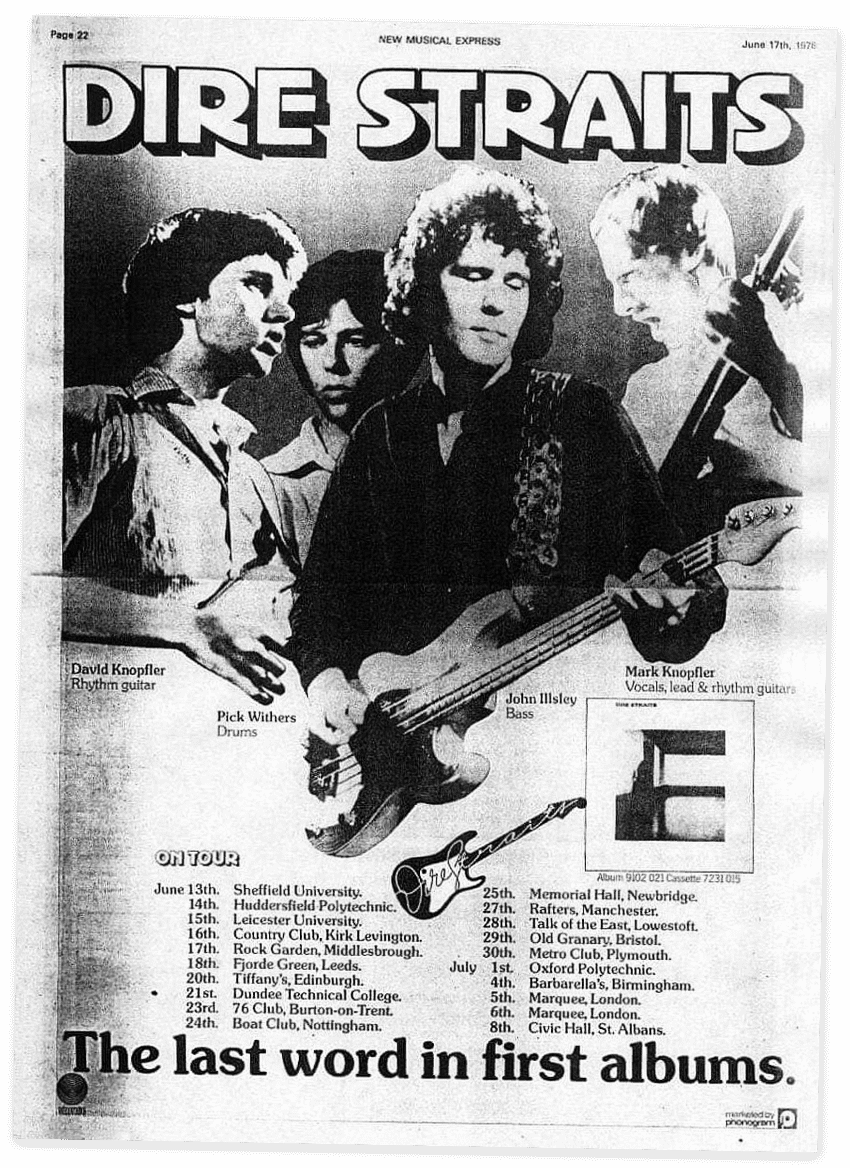When you think about Dire Straits, what comes to mind? For many, it’s the hauntingly beautiful guitar riffs of "Sultans of Swing," the emotional depth of "Brothers in Arms," or the timeless storytelling in their lyrics. But there’s so much more to this legendary band than just a few hit songs. Dire Straits is a phenomenon that transcends generations, and understanding its essence can give you a deeper appreciation for one of music's most iconic acts.
This band isn’t just about the music; it’s about the culture, the storytelling, and the way they connected with audiences worldwide. From their humble beginnings to becoming one of the best-selling artists of all time, Dire Straits left an indelible mark on the music industry. If you’ve ever wondered why this band remains relevant decades after their heyday, you’re in the right place.
In this comprehensive guide, we’ll dive deep into the phenomenon of Dire Straits. We’ll explore their history, their influence, the key players, and what makes their music so timeless. Whether you’re a die-hard fan or just discovering their music, this article will provide you with insights that go beyond the surface. So, grab your favorite beverage, and let’s embark on this musical journey!
Read also:Unlocking The Power Of Iot Data Visualization
Table of Contents
- The Origins of Dire Straits
- Key Players: Who’s Who in Dire Straits
- Their Breakthrough and Rise to Fame
- Iconic Albums That Defined an Era
- The Influence of Dire Straits on Modern Music
- Live Performances: The Heart of Their Legacy
- The Art of Songwriting in Dire Straits
- Guitar Magic: Mark Knopfler’s Signature Sound
- Cultural Impact: Beyond the Music
- The Enduring Legacy of Dire Straits
The Origins of Dire Straits
Every great story has a beginning, and Dire Straits’ story starts in the mid-1970s in London. The band was formed by Mark Knopfler, a guitarist and songwriter whose vision would shape the band’s sound and identity. Alongside him were his brother David Knopfler on rhythm guitar, John Illsley on bass, and Pick Withers on drums. The name "Dire Straits" itself is a reflection of the financial struggles they faced early on, but little did they know that their band would become synonymous with success.
What set Dire Straits apart from the outset was their unique blend of rock, blues, and folk influences. Mark Knopfler’s fingerpicking style on the guitar created a sound that was both intricate and accessible, appealing to a wide audience. Their debut album, simply titled Dire Straits, was released in 1978 and included the breakout hit "Sultans of Swing." This track, with its storytelling lyrics and unforgettable guitar solo, became a defining moment for the band and launched them into the international spotlight.
Early Challenges and Triumphs
Like many bands, Dire Straits faced challenges early on. The music industry in the late 1970s was highly competitive, and breaking through required more than just talent. However, their dedication to crafting meaningful music and their ability to connect with listeners paid off. The band’s early success was built on a foundation of hard work, innovative songwriting, and a sound that resonated with audiences worldwide.
By the time their second album, Communiqué, was released in 1979, Dire Straits had already established themselves as a force to be reckoned with. Tracks like "Romeo and Juliet" and "Once Upon a Time in the West" showcased their ability to tell compelling stories through music, further cementing their place in the hearts of fans.
Key Players: Who’s Who in Dire Straits
The success of Dire Straits wouldn’t have been possible without the contributions of its key players. While Mark Knopfler is often seen as the face of the band, each member played a crucial role in shaping its sound and legacy. Here’s a closer look at the individuals who made Dire Straits what it is:
Mark Knopfler: The Visionary
As the lead guitarist and primary songwriter, Mark Knopfler is the creative force behind Dire Straits. His distinctive guitar style and poetic lyrics are the backbone of the band’s music. Knopfler’s ability to weave intricate narratives into his songs has earned him a reputation as one of the greatest songwriters of his generation.
Read also:Notti Osama Death Footage The Truth Behind The Viral Sensation
David Knopfler: The Quiet Contributor
David Knopfler, Mark’s younger brother, was the original rhythm guitarist for Dire Straits. His contributions to the band’s early albums were significant, but he left the group in 1980, citing creative differences. Despite his relatively short tenure, David’s influence on the band’s early sound cannot be overstated.
John Illsley: The Steady Backbone
John Illsley’s bass playing provided the solid foundation that allowed Dire Straits to explore more complex musical landscapes. His ability to adapt to different styles and his unwavering commitment to the band made him an indispensable member.
Pick Withers: The Heartbeat
Pick Withers, the band’s original drummer, brought energy and precision to Dire Straits’ music. His work on tracks like "Sultans of Swing" and "Romeo and Juliet" remains some of the most memorable drumming in rock history.
Their Breakthrough and Rise to Fame
Dire Straits’ breakthrough came with the release of their debut album in 1978. The album’s lead single, "Sultans of Swing," became a global hit, propelling the band to international fame. The song’s success was a testament to the band’s ability to create music that was both commercially viable and artistically significant.
Over the years, Dire Straits continued to push boundaries and redefine what rock music could be. Their third album, Love Over Gold, released in 1982, featured epic tracks like the title song and "Telegraph Road," showcasing their storytelling prowess and musical versatility. By the time they released Brothers in Arms in 1985, Dire Straits had become a household name, with the album selling over 30 million copies worldwide.
The Evolution of Their Sound
One of the reasons Dire Straits remained relevant throughout their career was their willingness to evolve. While their early work was rooted in a blues-rock sound, later albums incorporated elements of jazz, country, and even electronic music. This evolution kept their music fresh and engaging, ensuring that they continued to captivate new audiences while retaining their loyal fanbase.
Iconic Albums That Defined an Era
Dire Straits’ discography is a treasure trove of iconic albums that have left an indelible mark on the music industry. From their self-titled debut to the monumental Brothers in Arms, each album tells a story and captures a moment in time. Here’s a closer look at some of their most celebrated works:
- Dire Straits (1978) – Featuring hits like "Sultans of Swing," this debut album introduced the world to the band’s unique sound.
- Communiqué (1979) – With tracks like "Romeo and Juliet," this album solidified their place in the rock canon.
- Love Over Gold (1982) – Known for its epic storytelling, this album includes the 14-minute title track.
- Brothers in Arms (1985) – A landmark album that sold over 30 million copies, featuring hits like "Money for Nothing" and "Walk of Life."
What Makes These Albums Iconic?
The enduring appeal of Dire Straits’ albums lies in their ability to tell stories through music. Whether it’s the gritty realism of "Sultans of Swing" or the emotional depth of "Brothers in Arms," their songs resonate with listeners on a personal level. Additionally, their innovative use of technology, such as the digital recording techniques employed on Brothers in Arms, set them apart from their contemporaries.
The Influence of Dire Straits on Modern Music
Dire Straits’ influence extends far beyond their own music. Their unique sound and approach to songwriting have inspired countless artists across various genres. Bands like U2, Coldplay, and even modern rock acts cite Dire Straits as a major influence.
One of the key aspects of Dire Straits’ influence is their ability to blend different musical styles seamlessly. Their use of storytelling, intricate guitar work, and emotional depth has set a standard for what modern rock music can achieve. Moreover, their commitment to authenticity and artistic integrity continues to inspire musicians today.
Legacy in the Music Industry
Beyond their influence on other artists, Dire Straits has left a lasting legacy in the music industry. They were pioneers in using digital recording technology and were among the first bands to achieve massive success through music videos. Their ability to adapt to changing musical landscapes while staying true to their core sound is a testament to their enduring relevance.
Live Performances: The Heart of Their Legacy
While Dire Straits’ studio albums are celebrated for their craftsmanship, their live performances are equally legendary. Known for their energy, precision, and ability to connect with audiences, their concerts were unforgettable experiences. The band’s 1985 tour in support of Brothers in Arms is often regarded as one of the greatest rock tours of all time.
What set Dire Straits’ live performances apart was their ability to recreate the magic of their studio recordings while adding a personal touch. Mark Knopfler’s guitar solos, John Illsley’s bass lines, and the tight rhythm section created a sound that was both powerful and intimate.
Memorable Moments from Their Tours
Throughout their career, Dire Straits delivered countless memorable moments on stage. From the epic performances of "Brothers in Arms" to the soulful rendition of "Telegraph Road," their concerts were a celebration of music and storytelling. Fans who were lucky enough to see them live often describe it as a life-changing experience.
The Art of Songwriting in Dire Straits
At the heart of Dire Straits’ music is their songwriting. Mark Knopfler’s ability to craft lyrics that tell compelling stories is one of the band’s defining characteristics. Whether it’s the gritty realism of "Sultans of Swing" or the emotional depth of "Brothers in Arms," his songs resonate with listeners on a personal level.
What makes Dire Straits’ songwriting so effective is their attention to detail. Each song is meticulously crafted, with every word and note serving a purpose. This dedication to their craft has resulted in some of the most iconic songs in rock history.
Key Themes in Their Lyrics
Many of Dire Straits’ songs explore themes of love, loss, and the complexities of modern life. Tracks like "Romeo and Juliet" and "Brothers in Arms" delve into the intricacies of relationships, while songs like "Money for Nothing" offer social commentary. This ability to tackle a wide range of subjects with depth and nuance is a testament to their songwriting prowess.
Guitar Magic: Mark Knopfler’s Signature Sound
No discussion of Dire Straits would be complete without mentioning Mark Knopfler’s guitar work. His fingerpicking style and signature sound have become synonymous with the band’s identity. Whether it’s the hauntingly beautiful riffs of "Sultans of Swing" or the powerful solos in "Brothers in Arms," Knopfler’s guitar playing is a masterclass in musical expression.
What sets Knopfler apart from other guitarists is his ability to convey emotion through his playing. Each note he plays seems to tell a story, adding layers of meaning to the band’s music. His influence on guitarists around the world is immeasurable, and his contributions to the world of music continue to inspire new generations.
Key Techniques and Influences
Knopfler’s guitar style is a blend of various influences, including blues, jazz, and folk. His use of fingerpicking, combined with his ability to incorporate complex harmonies, creates a sound that is both


